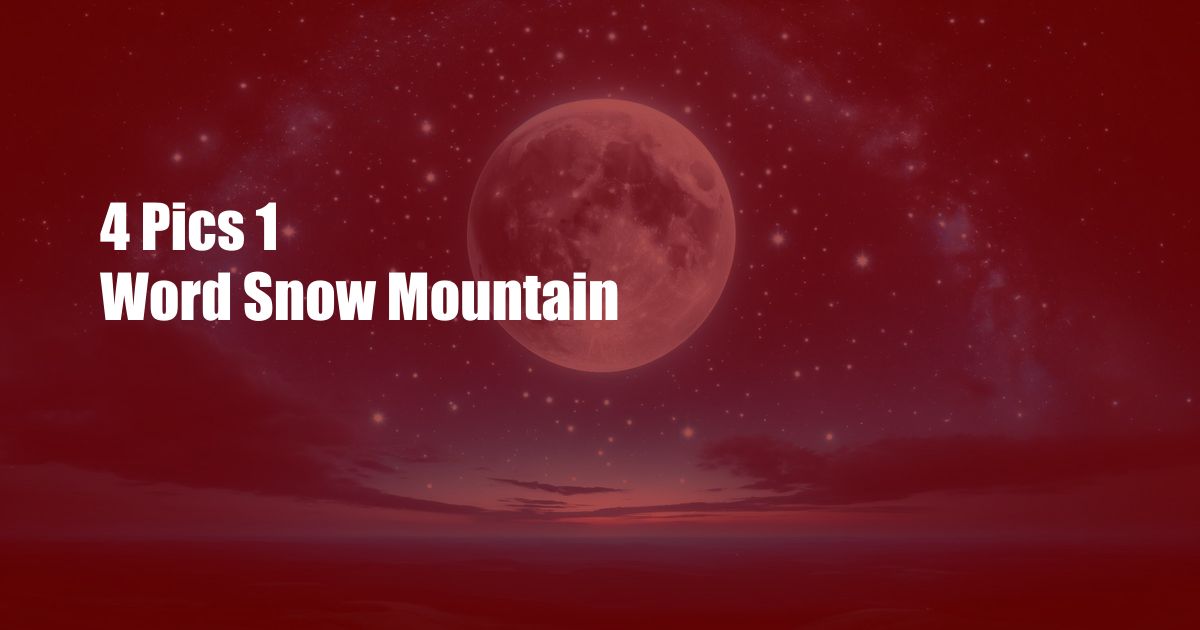
A Snowy Escape: Exploring the Majestic 4 Pics 1 Word Snow Mountain
As a seasoned word game enthusiast, I’ve encountered countless puzzles that have tested my wit and vocabulary. However, one that left an indelible mark on my mind was a particular challenge involving four pictures and one elusive word: snow mountain.
The image that emerged was breathtaking – a towering, snow-capped peak piercing the heavens, its pristine slopes glistening in the sunlight. It evoked a sense of both awe and wonder, beckoning me to unravel its hidden depths.
The Majesty of Snow Mountains
Snow mountains are more than just geological formations; they are symbols of resilience, grandeur, and untamed nature. Their immense size and imposing presence have inspired countless stories, legends, and works of art throughout history.
From the towering Himalayas, known for their spiritual significance, to the rugged Alps, which attract mountaineers and skiers alike, snow mountains captivate our imaginations. Their icy summits and treacherous slopes challenge our limits, while their pristine beauty provides solace and rejuvenation.
The Formation of Snow Mountains
Snow mountains are formed through a process called glaciation. When snow accumulates and compresses over time, it transforms into ice. The weight of the ice causes the glacier to move, carving valleys and shaping the landscape.
As the glacier retreats, it leaves behind a U-shaped valley and a towering peak. These peaks, often adorned with glaciers and snowfields, are the telltale signs of a snow mountain’s past.
The Impact of Snow Mountains
Snow mountains have a profound impact on the surrounding environment. They serve as vital sources of fresh water, providing nourishment for ecosystems downstream. The snowpack also regulates the climate, reflecting sunlight and cooling the surroundings.
Snow mountains are also important habitats for a diverse range of flora and fauna. Alpine meadows bloom with wildflowers during the summer months, attracting pollinators and other insects. Higher up, animals such as mountain goats, snow leopards, and even polar bears have adapted to survive in these harsh conditions.
The Lure of Snow Mountains
The allure of snow mountains is undeniable. Mountaineers are drawn to their challenging slopes and breathtaking views. Skiers and snowboarders seek out their powdery slopes and exhilarating runs.
Hikers and nature enthusiasts appreciate the serenity and beauty of the alpine environment. Whether it’s exploring hidden trails, admiring frozen waterfalls, or simply marveling at the vastness of the wilderness, snow mountains offer endless opportunities for adventure and introspection.
Tips for Exploring Snow Mountains
Before embarking on an adventure in the snow mountains, it’s crucial to take precautions and prepare for the challenges you may encounter.
Here are some expert tips to ensure a safe and enjoyable experience:
- Plan ahead: Research the area you’re visiting, check weather forecasts, and inform someone about your itinerary.
- Pack appropriately: Bring warm clothing, sturdy footwear, and plenty of water. Consider bringing a first-aid kit and other emergency supplies.
- Stay alert: Be aware of your surroundings and potential hazards such as avalanches, crevasses, and wildlife.
- Follow marked trails: Stick to established paths to avoid getting lost or injured.
- Respect the environment: Pack out what you pack in, and avoid disturbing wildlife or damaging the fragile ecosystems.
FAQs about Snow Mountains
Q: What is the difference between a snow mountain and a glacier?
A: A snow mountain is a peak or range that is predominantly covered in snow and ice. A glacier is a large body of ice that moves slowly over time, carving out the landscape as it passes.
Q: Are snow mountains safe to climb?
A: Climbing snow mountains can be dangerous and should only be attempted by experienced mountaineers with proper equipment and training. Always check weather conditions and consult with local authorities before embarking on a climb.
Q: What are the best times to visit snow mountains?
A: The best times to visit snow mountains depend on the activity you’re planning. For skiing and snowboarding, the winter months are ideal. For hiking and photography, the spring and summer months offer milder temperatures and fewer crowds.
Conclusion
Snow mountains stand as beacons of beauty and inspiration, reminding us of the vastness and wonder of our planet. They are places where we can challenge ourselves, connect with nature, and create lasting memories.
Whether you’re a seasoned adventurer or simply seeking a breathtaking escape, snow mountains offer something for everyone. Embrace the opportunity to explore these majestic peaks, and let their grandeur and tranquility fill you with awe and wonder.
Are you ready to embark on your next snow mountain adventure?

 Hogki.com Trusted Information and Education News Media
Hogki.com Trusted Information and Education News Media